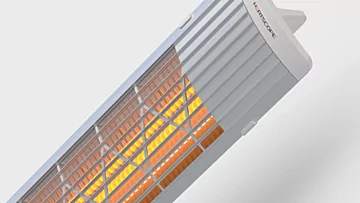Difference between radiant heaters and infrared heaters
Heating method
Loading image...


Both radiant and infrared heaters use electromagnetic radiation to directly heat objects and people in their path, rather than heating the air.
They emit infrared waves, which are a type of electromagnetic radiation.
Terminology
The main difference is in the terminology used:
- Radiant heater refers to the method of heat transfer (radiation)
- Infrared heater specifies the type of radiation used (infrared waves)
How they work
Loading image...


These heaters typically contain a heating element, often made of nickel-chromium alloy, that emits infrared radiation when electricity passes through it.
This radiation then directly warms objects and people in its path.
Key Characteristics
- Directional heating: They provide targeted warmth to specific areas
- Instant heat: Warmth is felt immediately upon turning on
- Energy efficiency: They can be more efficient than convection heaters, especially in open or outdoor spaces
- Silent operation: No fans or moving parts means quiet heating
Best applications
Radiant/infrared heaters are particularly effective for:
- Outdoor spaces
- Large, open indoor areas
- Spot heating specific zones
- Spaces with high ceilings or poor insulation
In summary, there is no fundamental difference between radiant heaters and infrared heaters - they are essentially the same technology described with slightly different terminology.
How do infrared heaters compare to traditional convection heaters in terms of efficiency?
Infrared heaters and traditional convection heaters differ significantly in their heating methods and efficiency:
Heating method
- Infrared heaters emit electromagnetic radiation that directly warms objects and people in their path, without heating the air.
- Convection heaters warm the air, which then circulates to heat the entire room.
Energy efficiency
- Infrared heaters are generally more energy-efficient, consuming approximately 30% less energy compared to traditional heating systems.
- They provide instant heat and can reach target temperatures quickly with minimal energy use.
- Convection heaters are slower to warm a space and may be less efficient, especially in larger or poorly insulated areas.
Targeted heating
- Infrared heaters offer more directional and targeted heating, making them ideal for specific areas or outdoor spaces.
- Convection heaters are better suited for heating entire enclosed rooms.
Heat retention
- Infrared heat is absorbed by objects in the room, which then radiate warmth back into the space, potentially leading to longer-lasting warmth.
- Convection heat can rise to the ceiling or escape through gaps, requiring more frequent reheating.
Operating costs
- Infrared heaters typically have lower operating costs due to their energy efficiency.
- Convection heaters may have higher running costs, especially in larger spaces or areas with poor insulation.
Environmental impact
- Infrared heaters are often considered more environmentally friendly as they don't rely on combustion and can be powered by renewable energy sources.
In summary, infrared heaters are generally more efficient and cost-effective for targeted heating, especially in open or poorly insulated spaces. However, the best choice depends on the specific heating needs, room size, and usage patterns.